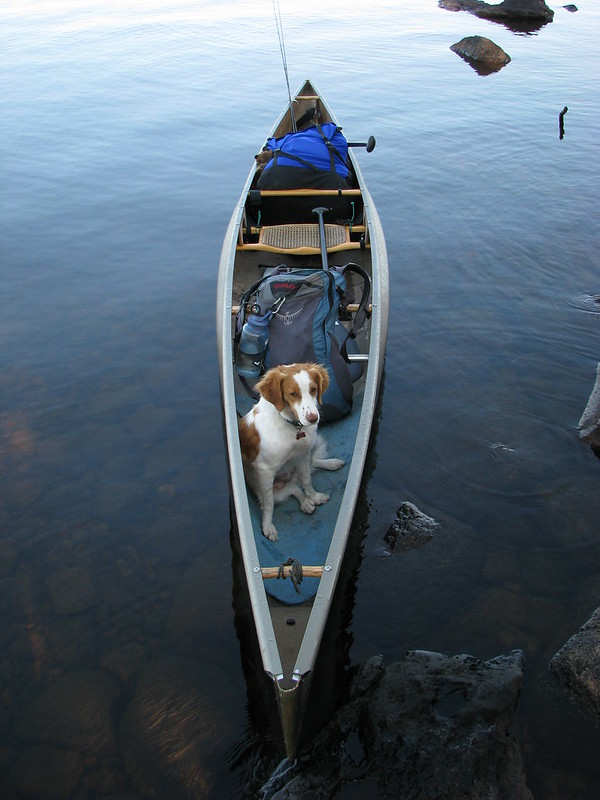I got my last dog from an animal rescue, first dog I haven't gotten as a puppy. Was a bit nervous about it since you never know what they've been through and how it will affect them the rest of their lives. I got lucky though and she's the best dog I've ever had. First dog I've ever had that only responds to positive reinforcement and wants nothing more than to please you. If you get really mad and start yelling she kind of locks up and just wants to stand by your leg for protection. It's hard to remember that no matter how mad you are you can't take it out on her. Maybe that's a good thing to learn from a dog.
Anyway, I had some specific size requirements when looking for a dog. Slender and long legged so they could get through the tall grass on my many walks through the prairie but also small and lightweight so that it would fit nicely in a canoe. What I ended up with appears to be a 27 pound Brittany Spaniel who, at one year old when I got her, took to a canoe like a fish to water, even though when on shore she wouldn't come within 2 feet of the water.
She's been my constant companion the past 4 or so years. We've done a couple weeks in WCPP, lots of day and weekend trips, and a few cross country road/camping trips. Any time we travel I'm amazed how quickly she settles into the routine and takes it all in stride. For any dog to be a good travel/tripping companion I think you have to spend a lot of time with them....a lot of time. They pick up on all sorts of gestures, phrases and tones in your voice and you do the same for them. If they know you're relaxed than they're relaxed. For me and Sadie a two week camping/canoe trip really isn't that different from our normal life. Lots of time spent outdoors and traveling in the car and eating at odd hours. But the smells and scenery are different.
While I don't spend a lot of time training my dogs they're all well behaved and know basic commands and how to obey them, which is critical when traveling and tripping. When you tell them to come they need to come, now! They need to know that when you tell them to get into the canoe they need to get in and when you tell them to get out they need to get out. Sadie is free to run around at will when we're hiking because she doesn't get far and always comes when called, but she also knows that when I tell her to heel she needs to heel. If we're in town and she kicks up a rabbit a sharp "hey!" will stop her in her tracks in mid-chase. Never had a dog that would do that before.
I did use a shock collar on her when I first got her. If she started chasing a deer or rabbit she'd completely ignore me and nothing makes me madder. But you can't be mad when they do come back because that will just confuse them. She was also wandering out onto the road at times at home but I couldn't get her to figure out that was a really bad thing to do. As soon as I'd see her on the road and yell to "come" she'd come bounding up to me just as happy as can be because she was wanted. She did exactly what I wanted her to so I couldn't scold her and it wasn't sinking in that the road was bad.
I think she only got shocked twice by the collar. That was enough, she's a quick learner. They give a beep before they shock and you also have the option of beeping only, without the shock. After that all I had to do was give a beep and she'd stop so fast she'd almost do a somersault. A beep or shock was never given unless she ignored a voice command so she quickly figured out what it was all about. Except when it came to the road. If I saw her get within 20 feet of it I'd give her a beep with no voice command (because I knew she'd obey by voice and not "get it").
Wow, that turned into quite a ramble. That's what happens when you get me talking about my dog.
The first day I got her and her first time in a canoe:
 20100711_012 copy_web
20100711_012 copy_web by
Alan Gage, on Flickr
Our last morning in WCPP:
 20120828_003
20120828_003 by
Alan Gage, on Flickr
 20120828_007
20120828_007 by
Alan Gage, on Flickr
Good luck with the new dog, it's always an adventure!
Alan




